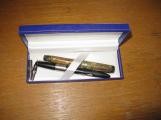1
Writing MaterialsIn the early 1900ís some students had slates and slate pencils. The slate pencils were about four inches long and a bit smaller around than a macaroni stick. If you didnít hold the pencil properly it made a squeaking noise. You also needed a damp cloth to wipe the slate clean. If the cloth got a little too dry and you thought nobody was looking you spit on the cloth to dampen it.
From slates they graduated to scribblers and pencils. The pencils they could get from Mr. Thorpe for nothing, but they had no eraser on the end. Mr. Thorpís store name was on the side of it. The pencil scribblers had cute pictures of dogs, cats and kids on the front and they cost five cents. They were used for arithmetic. Soon it was ink scribblers. They were much thinner and had scenery on the front. They cost five cents as well. Next came the thicker scribblers. They were plain colors, red, blue and green and they cost ten cents. You either bought a pencil with an eraser from Mr. Blish for five cents or got a free one from Mr. Thorpe, without an eraser.
The students learned to write with straight pens and nibs. They were pretty scratchy and messy. Their school work usually ended up with a lot of blotches and spatters. Next was the fountain pen, quite an improvement over the straight pen. If you got ink on your clothes it was there to stay.
Every desk had an ink well. These ink wells held an ink bottle. The bottles were filled from a quart sized bottle kept in the supply cupboard. Filling the small bottles could be quite a messy job.
3
Times Tables on Back of ScribblerTimes Tables on Back of Scribbler
Bentley, Alberta
 Credits:
Credits:Bentley Museum Society




